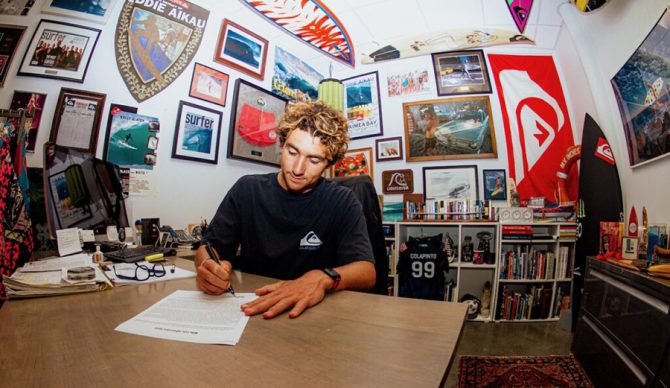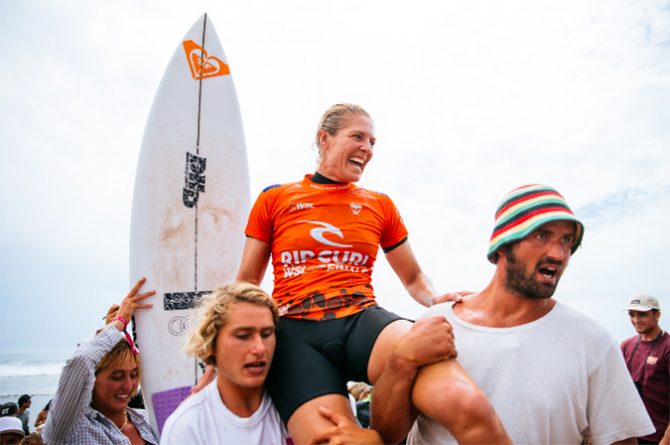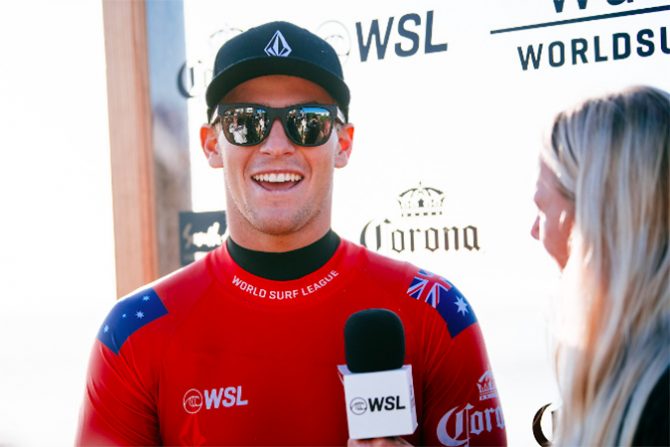
Griffin Colapinto’s recent move was simply the latest in a series of high-profile sponsorship switcheroos. How does it all end? Photo: Quiksilver
The entire surf industry runs on the “team rider” business model. Always has and, until it dies a horrible death in a dust bowl strip mall, probably always will. Surfers become synonymous with a brand, and the sticker that juts out on the nose of their surfboard becomes an extension of themselves. Until it doesn’t.
Griffin Colapinto’s recent switch from Billabong, after a ten-year association, to rival Quiksilver (even if both brands are owned by the same global asset management firm) provided the most recent shock to the surfing ecosystem. But it certainly wasn’t the first. Following are several other seismic shifts in surfing sponsorships… and how they panned out.
Kelly Dumps Quiksilver
On April 1, 2014, a press release announced that Kelly Slater was leaving Quiksilver. Kelly had been with the company for 25 years, won 11 World Titles, and had been a cornerstone of the brand’s domination of the surf market. Such was their close association; the announcement was seen by many as a well-compiled April Fool’s Joke.
However, when Kelly surfed a heat at Margaret River a few days later sans Quiksilver tattoo, the move was confirmed. Slater announced that he’d left Quik to partner with the Kering Group in several endeavors, starting with his brand Outerknown. Many Slater fans, in a move akin to returning to the street corner where they lost their dog years ago, still associate Kelly with the mountain and wave logo. And without knowing the financials on Outerknown, I’d say the jury’s still out?

Steph’s switch worked out okay. Photo: WSL
Steph Gilmore Skips From Rip Curl to Quik (to Roxy)
Steph Gilmore lifted the first half of her eight World Titles with a Rip Curl hat upon her head. However, in 2011 aged 22, after a decade with the company, she skipped to cross-town Torquay rivals to sign with the recently formed Quiksilver Womens brand.
At the time Gilmore said the move, “wasn’t a monetary thing” and that she wanted to “keep things fresh.” Though with the five-year deal rumored to be worth more than $A5 million, the coin may have played a small part. Quiksilver Women morphed into QSW before being disbanded in 2013. Steph’s contract was taken up by stablemate Roxy. She’s been there ever since.
Everyone… to Hurley
Rob Machado started the ball rolling in 2002 when his move from Gotcha to Hurley was the first big grab for the brand. Hurley had just been purchased by Nike, and the Swoosh’s pull (under the short-lived surf and skate brand Nike 6.0) was critical in later pulling a whole team of surf stars from their established sponsors.
By 2013 John John Florence (O’Neill), had joined Julian Wilson (Quiksilver), Carissa Moore (Roxy) Koloho Andino (Billabong), and Michel Bourez (Quiksilver) on the Hurley team. That lasted until 2020 when the sale of the company led to the anchor rope being cut on a slew of the world’s best surfers. Many are still adrift.
Parko Swaps Sleds From DHD to JS
While Luke Egan had moved between Gold Coast shapers Darren Handley of DHD Designs to Jason Stephenson (JS Surfboards), it was Joel Parkinson’s switch that was more pivotal. Around 2004, Handley was Australia’s, if not the world’s, dominant shaper with Fanning and Parkinson the brand’s highest-profile test pilots. Such was the close surfer-shaper relationship, Handley said at the time, “I see Mick more as a son and Joel as a brother.”
JS had worked under Handley for four years, and Parko’s transition signaled that the apprentice was taking on the master. Twenty years down the track, with Parko and a clutch of the world’s best surfers still sporting the Traktor logo, those early signs were correct.

New contract for Mr. Robinson? Photo: WSL
Jack Robinson Romances The Stone
The West Oz prodigy had reversed Colapintoed, moving from Quiksilver to Billabong when he was 16. Three years later in 2019, when Robinson won the Volcom Pipe Pro and moved closer to CT qualification, it was assumed he’d resign with Bong, all be it on better terms.
In a shock move though he instead peeled back the double wave and replaced it with a Stone, doubling his wage with the new Volcom contract. The partnership immediately made sense for the hard-charging Aussie, who counted Hawaii as a second home. He would go on to qualify for the CT in 2021, then win two events and finish as the World No. 2 in 2022. Time to look for a new contract?

